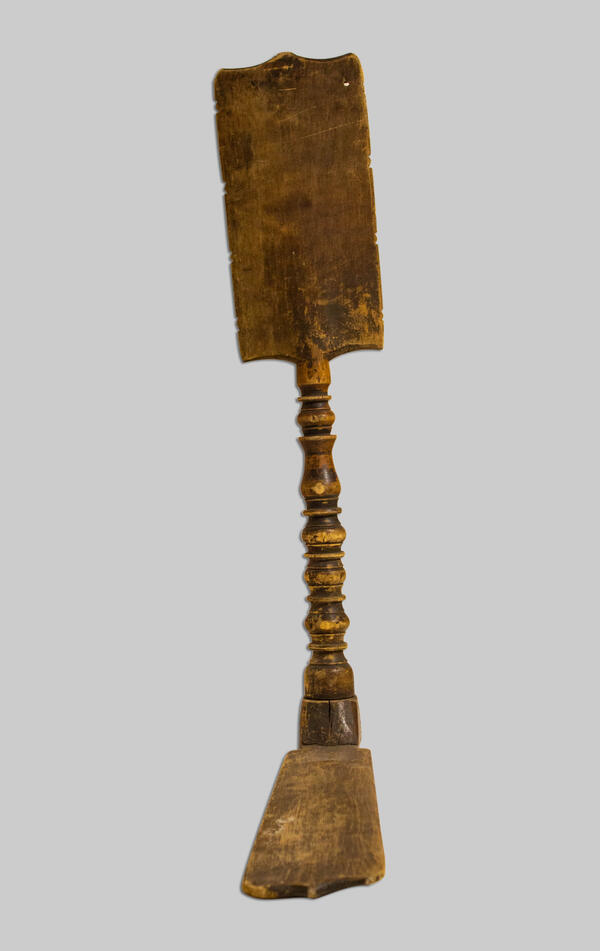First manual distaffs were used 2,500 years ago in India. The Russian tradition of making thread using a distaff also dates back centuries. A distaff could be found in every home in Russia. A vast number of superstitions, rituals and beliefs are associated with this household item in our culture.
In Russia, spinning was initially a job reserved for girls and women. Girls would start spinning at the wheel between the ages of five and seven, and did not part with the job for the rest of their lives. By the age of 18, girls became skilled craftswomen, which, according to popular beliefs, contributed to a successful marriage. Often, a large group of girls got together in one house: they spun, sang, and received guests: young men who came to meet girls and look for brides.
Hand distaff were of two types: one-piece and built-up. Tow was wound on the upper vertical part of the distaff, and the spinner sat on the lower part: a wide stand, called ‘bottom’ (bench). The top part of the distaff could have a ‘comb’ for the tow or ‘lopat’ (‘lopaska’, the blade) for winding the tow around. Below was the ‘leg’ of the distaff, or ‘neck.’ Traditionally, the neck was made rounded. In built-up distaffs, such as this exhibit, the ‘neck’ was inserted into a special bulge with a hole in the bottom, called ‘butt-end.’ This name came from the fact that in the old days the bottoms were made from the butt of a tree: the lower thick part of the trunk adjacent to the root.
Another indispensable spinning tool was the spindle: a small chiseled stick with a sharp point at one end and a bulge at the other. The spinner wound the thread she was making on the spindle. The built-up distaff was kept the disassembled. When the work was finished, the spinner took out the comb and hung the bottom on the wall. The bottom was often covered with painted or carved ornaments and served as kind of a decoration for the house. The top part was often decorated: the neck and the ‘blade’ were often covered with carvings or a bright-colored painting. Traditionally, they depicted sun symbols and ornaments with plant or animal designs. However, the distaff could also be decorated with scenes from Scripture or scenes from everyday life. A small hole was made in the ‘blade’ to hang the top part as a decoration. Today, the diverse decor of distaffs serves as a kind of repository of the people’s memory.
In Russia, spinning was initially a job reserved for girls and women. Girls would start spinning at the wheel between the ages of five and seven, and did not part with the job for the rest of their lives. By the age of 18, girls became skilled craftswomen, which, according to popular beliefs, contributed to a successful marriage. Often, a large group of girls got together in one house: they spun, sang, and received guests: young men who came to meet girls and look for brides.
Hand distaff were of two types: one-piece and built-up. Tow was wound on the upper vertical part of the distaff, and the spinner sat on the lower part: a wide stand, called ‘bottom’ (bench). The top part of the distaff could have a ‘comb’ for the tow or ‘lopat’ (‘lopaska’, the blade) for winding the tow around. Below was the ‘leg’ of the distaff, or ‘neck.’ Traditionally, the neck was made rounded. In built-up distaffs, such as this exhibit, the ‘neck’ was inserted into a special bulge with a hole in the bottom, called ‘butt-end.’ This name came from the fact that in the old days the bottoms were made from the butt of a tree: the lower thick part of the trunk adjacent to the root.
Another indispensable spinning tool was the spindle: a small chiseled stick with a sharp point at one end and a bulge at the other. The spinner wound the thread she was making on the spindle. The built-up distaff was kept the disassembled. When the work was finished, the spinner took out the comb and hung the bottom on the wall. The bottom was often covered with painted or carved ornaments and served as kind of a decoration for the house. The top part was often decorated: the neck and the ‘blade’ were often covered with carvings or a bright-colored painting. Traditionally, they depicted sun symbols and ornaments with plant or animal designs. However, the distaff could also be decorated with scenes from Scripture or scenes from everyday life. A small hole was made in the ‘blade’ to hang the top part as a decoration. Today, the diverse decor of distaffs serves as a kind of repository of the people’s memory.



